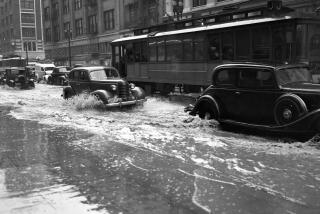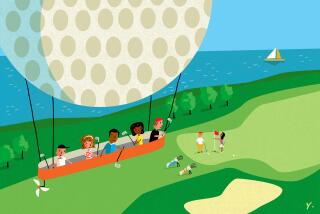Be Delightful When Weather Gets Frightful
Granted, we donât have much weather here in Southern California.
It would be foolish to liken Pacific breezes, generally little more than natural air conditioning, to the par-for-the-course winds that barrel off the North and Irish seas onto British and Scottish links.
Similarly, it would be silly to speak of the mist and sheet-like rain that envelop the UKâs seaside courses in the same breath as the rumor that is summertime rain in the Southland.
Los Angeles averages 0.01 of an inch of rain in July, according to the National Weather Service. Factor in an average high temperature of 75.3 degrees and low of 62.8 and the only challenge seems to be the wind off the ocean, averaging a shade below 8 mph in July.
But when winter rains hit, afternoon winds off the ocean gust to 30 mph or Santa Anas threaten to uproot trees and snap flagsticks, what then?
Generally, said Brian Gunson, director of golf at Shady Canyon in Irvine, recreational golfers in this part of the world pack it in.
âA lame excuse,â said Gunson, who for 23 years worked in Scotland at Turnberry Golf Links, site of three British Opens.
âIt rains so seldom here. Itâs nice to see a little inclement weather.â
If you agree, here are pointers for playing well in poor weather, culled from conversations with half a dozen local pros.
* Less is more: Ignore the instinct to overcompensate. Drop down one club if youâre hitting into a moderate wind -- if you hit a seven-iron from 150 yards, hit a six. Widen your stance to create a lower center of gravity and stand with the ball farther back in your stance. Use a three-quarter-length swing.
Donât swing harder. âAll that does is impart more backspin,â said Gunson. âThe ball goes higher rather than farther.â
Playing in the wind also requires relearning how far one can hit each club.
âYouâre thinking, âWhat can a seven-iron do? I have no idea,â â said Rick Peters, pro at the Bridges at Rancho Santa Fe. âYou need to visualize a trajectory. If thatâs what Iâm used to seeing a six-iron do, hit it, even if, oh by the way, itâs 135 yards.â
* Been there, havenât done that: âGolfers, particularly country club players in many, many situations, try to hit shots they arenât capable of,â Peters said. âIn the heat of battle, one has to have a realistic view, to say, âOn a scale of one to 10, this is a 10 for difficulty, and my chances of pulling this off are one in a hundred.â
One Bridges member, the most skilled of all, still gets himself into trouble with that line of thinking.
âPhil will hit shots in his heart of hearts that he believes he can hit, so he tries,â Peters said. âOn occasion, itâs cost him.â
That would be Phil Mickelson.
* Why fly when you can run? Many holes prohibit bump-and-run approach shots because of bunkers or elevation, but use the technique when the course allows it. A lower ball flight will be much less affected by the wind. Learning this shot can help your game even in perfect conditions.
And in wet weather:
* Towel-dry your clubface: Moisture on the clubface reduces backspin and can cause the ball to take off.
âThe ball comes out like a knuckleball, flies a club farther and wonât check up,â said Gary Newman, a Pelican Hill pro. âFor your driver, though, thatâs fine.â
* In the rough, open wide: âYou have to open the blade in deep rough and hold it firm with the last three fingers of your [top] hand,â said Ray Carrasco, a European Tour pro and the senior pro at Pelican Hill. âThe wet grass will turn the clubface left.â
* Dress appropriately: Wayne Case, head pro at Sherwood Country Club in Thousand Oaks, carried fuel sticks in the sheepskin-lined pockets of his jacket when playing in the British Amateur in 1983 and â84.
Youâll probably need no such thing. The simple checklist: a waterproof windbreaker (the lighter the better), a cloth golf glove and extra towels. A cloth glove, which generally costs less than leather, works effectively when wet.
âYou can throw it in a puddle, grip a club and itâs great, full of control,â Gunson said. âIâve got one in my golf bag right now.â
If you want to be innovative, look no further than the late Payne Stewart and the 1999 U.S. Open at Pinehurst.
âHe had this jacket and he said, âIâm too hot, I canât stand it,â Carrasco recalled. âHe found some scissors and cut the sleeves at the elbow. Companies started making jackets with short sleeves or detachable sleeves.â
* Attitude is key: âIf you go with the idea that it will be a little rugged, you eat it up and embrace it,â Peters said. âAttitude has a lot to do with it.â
More to Read
Sign up for Essential California
The most important California stories and recommendations in your inbox every morning.
You may occasionally receive promotional content from the Los Angeles Times.










